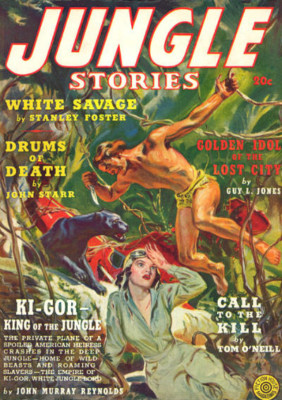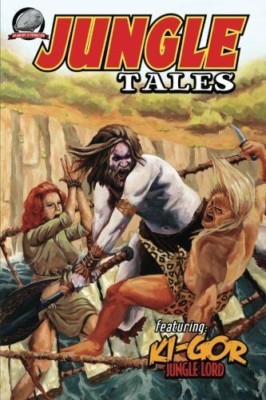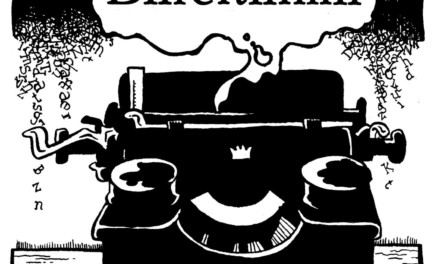 Back in 1938—85 years ago as of this writing—the first issue of Jungle Stories appeared. What makes this publication memorable is the issue’s featured story told a tale of Ki-Gor, a jungle hero who would become the most successful of many Tarzan knock-offs.
Back in 1938—85 years ago as of this writing—the first issue of Jungle Stories appeared. What makes this publication memorable is the issue’s featured story told a tale of Ki-Gor, a jungle hero who would become the most successful of many Tarzan knock-offs.
Ki-Gor wasn’t a complete Tarzan copy. He was a white man who lived in the jungle, had earned the trust and respect of the local tribes and leaders, and had a mate from civilization: Helene Vaughn, an American aviatrix who had crashed in the jungle.
Like Tarzan, Ki-Gor encountered many lost civilizations and faced threats from plenty of low-down villains from civilization. A few titles will suggest the flavor of his thrilling adventures:
 Ki-Gor and the Stolen Empire
Ki-Gor and the Stolen Empire- Ki-Gor and the Giant Gorilla-Men
- Ki-Gor and the Secret Legions of Simba
- The Paradise That Time Forgot
- The Temple of the Moon God
- Slaves for the Renegade Sultan
- Blood Priestess of Vig’Na
Jungle Tales pulp magazine was published by Glen-Kel Publishing Company, which in some fashion confusing to me is also—or became—Fiction House, which also published comic books, including one titled Jungle Comics. The character from that comic title who became best known is Sheena, Queen of the Jungle, who’s had her own run of fame and fortune.
Ki-Gor always appeared in Jungle Tales. Tarzan, on the other hand, while more famous, appeared in several magazines over the course of his 24 books: The first was the October 1912 issue of The All-Story, which—instead of serializing the novel, as was the case for most novel-length works appearing in magazines of the time—released the entire novel in a single issue; other magazines that featured Tarzan novels were Argosy, Blue Book Magazine, Liberty, New Story Magazine, and Thrilling Adventures.
The original Tarzan books were written by Edgar Rice Burroughs. Ki-Gor’s adventures were credited to John Peter Drummond. Drummond was a house name, much as Kenneth Robeson and Maxwell Grant were the attributed raconteurs for Doc Savage and The Shadow, respectively. Among the actual pulp fictioneers behind the Drummond name were Dan Cushman, James McKimmey, and Robert Turner. Cushman, in particular, was a prolific writer in the western and adventure genres. His novel, Stay Away, Joe, was adapted into an Elvis Presley movie in 1968.
Burroughs wrote 24 Tarzan books from 1912 to 1941. Ki-Gor, on the other hand, appeared in 59 tales from 1938 to 1954. Burroughs, of course, wrote his own novels and interspersed his work on the popular Tarzan stories with works about other characters and settings, such as the Mars (Barsoom), Pellucidar, and Venus books. Ki-Gor was written by a number of fictioneers and his adventures appeared with regular frequency in a single newsstand title.
Peter Currane has a nice online Ki-Gor bibliography with some background information about the character’s publishing history.
 I’ve tried my hand at a couple of Ki-Gor tales. As a Tarzan fan with a hankering to write from a young age, I doubted my dream of someday penning a Tarzan adventure would ever come true; so I focused my attention to the most successful Tarzan clone, Ki-Gor:
I’ve tried my hand at a couple of Ki-Gor tales. As a Tarzan fan with a hankering to write from a young age, I doubted my dream of someday penning a Tarzan adventure would ever come true; so I focused my attention to the most successful Tarzan clone, Ki-Gor:
- “Moon of the Demon Men” in Ki-Gor: Jungle Lord published by Wildcat Books. This one has some Lovecraftian/Elder Gods touches that makes it particularly hair-raising. Available only as a print book, and only from Amazon.
- “The Devil’s Nest” in Jungle Tales Volume 1 from Airship 27. Ki-Gor faces normal human villainy while tracking down the lost heir to a vast fortune. And there’s baseball. This one is available as a paperback from Amazon and Barnes & Noble, and as a Kindle ebook from Amazon. There’s also an audiobook edition from Radio Archives.
These were fun to write, and I think the pleasure I had in writing them comes through in the reading.
By the way, Steeger Books is reprinting all the Ki-Gor pulp magazine stories in original order. The project has reached four volumes so far:
- Volume 1: Stories from 1938 – 1940
- Volume 2: Stories from 1940 – 1941
- Volume 3: Stories from 1941 – 1942
- Volume 4: Stories from 1942 – 1943


